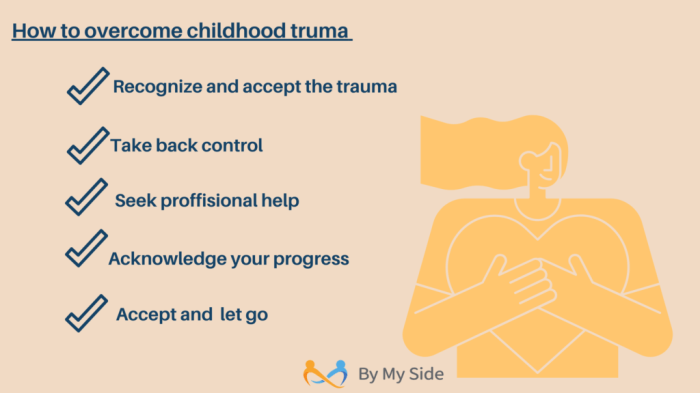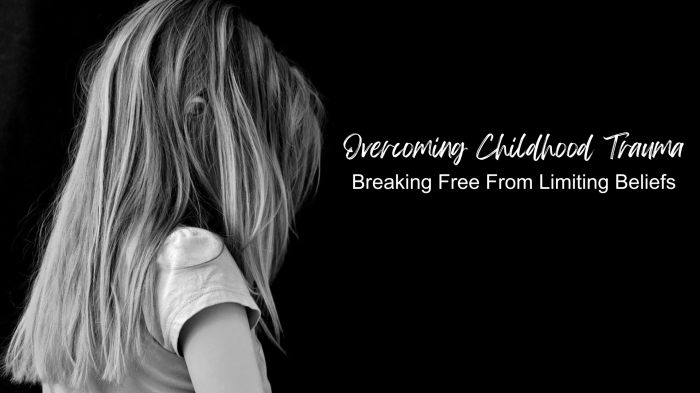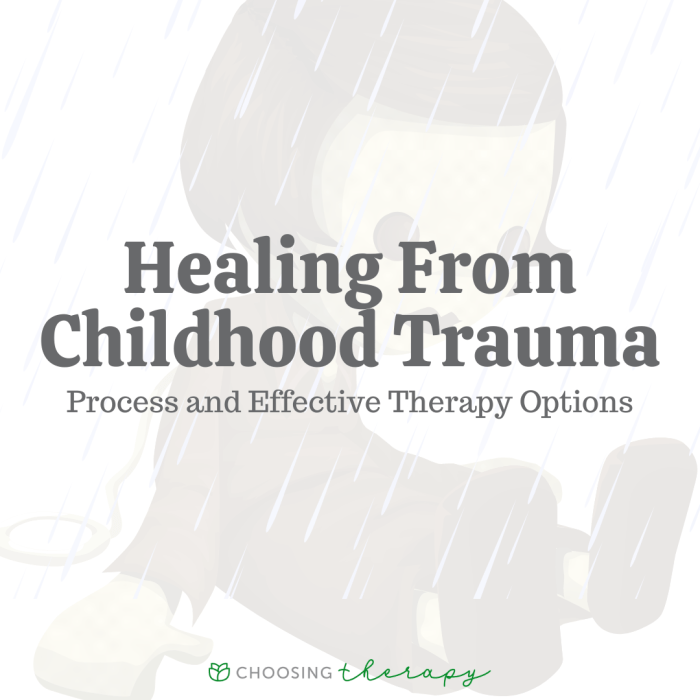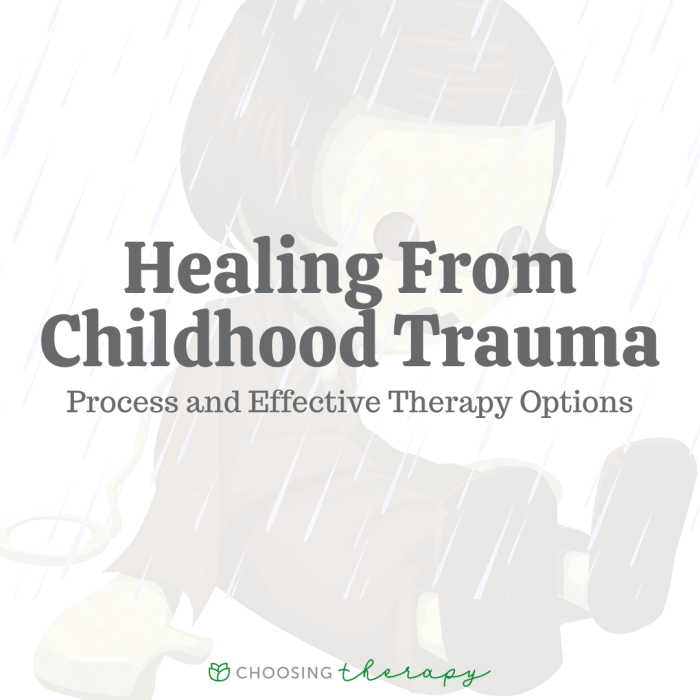Let’s face it, childhood trauma can be a real downer. It’s like that one bad episode of your favorite show that you just can’t seem to forget. But what if I told you there’s a cool technique called B.R.E.A.T.H.E. that can help you chill out and deal with those lingering issues?
It’s like hitting the reset button on your emotional rollercoaster, but in a way that’s totally empowering and awesome.
This guide dives deep into the world of childhood trauma, explaining its impact and how it can manifest in adulthood. We’ll break down the B.R.E.A.T.H.E. technique, showing you how it can help you conquer those tough emotions and find your inner peace.
Plus, we’ll take a look at the book “If No One Was There For You,” which offers a powerful perspective on healing and finding your way back to a brighter future.
Understanding Childhood Trauma and its Impact

Childhood trauma is a serious issue that can have a profound impact on an individual’s life. It refers to any adverse experience that occurs during childhood, which can significantly affect a child’s development and well-being. This trauma can manifest in various ways, shaping a person’s emotional, behavioral, and physical health in adulthood.
Types of Childhood Trauma
Childhood trauma can take many forms, and each type can have unique long-term consequences. Here are some common types:
- Physical abuse:This involves any form of physical harm inflicted on a child, such as hitting, kicking, burning, or shaking. It can lead to chronic pain, physical disabilities, and increased risk of substance abuse and mental health issues.
- Sexual abuse:This involves any sexual activity with a child, including rape, molestation, and sexual exploitation. It can result in PTSD, depression, anxiety, and difficulty forming healthy relationships.
- Emotional abuse:This involves verbal or psychological abuse that damages a child’s self-esteem and emotional well-being. It can include constant criticism, threats, insults, and manipulation. Long-term effects can include low self-worth, difficulty regulating emotions, and increased risk of depression and anxiety.
- Neglect:This involves the failure to provide a child with basic needs, such as food, shelter, clothing, medical care, and emotional support. It can lead to developmental delays, physical health problems, and behavioral issues.
- Witnessing violence:Children who witness violence, such as domestic abuse or community violence, can experience trauma similar to those who are directly abused. It can lead to PTSD, anxiety, and difficulty trusting others.
Impact of Childhood Trauma on Adulthood
Childhood trauma can have a lasting impact on an individual’s life, affecting various aspects of their well-being.
Emotional Symptoms
- Anxiety and depression:Childhood trauma can increase the risk of developing anxiety disorders, such as generalized anxiety disorder, panic disorder, and social anxiety disorder. It can also contribute to depression, characterized by feelings of sadness, hopelessness, and loss of interest in activities.
So, you’re working on those childhood trauma vibes with the B.R.E.A.T.H.E. technique, right? That’s awesome! And hey, if you’re looking for some chill activities to help with that patience thing, check out the Exercise Patience Kids Convention Workbook 2023 JW Convention Activity Notebook For Kids.
It’s not just for kids, you know. We all need a little help staying zen sometimes, especially when we’re working through tough stuff. Just remember, taking it one breath at a time, one page at a time, is the key to getting through it all.
- Post-traumatic stress disorder (PTSD):This disorder involves intrusive memories, nightmares, avoidance behaviors, and hyperarousal, triggered by reminders of the traumatic event. It can significantly impact an individual’s daily life and relationships.
- Difficulty regulating emotions:Trauma can disrupt a person’s ability to manage their emotions, leading to outbursts of anger, difficulty controlling impulses, and difficulty experiencing joy or intimacy.
- Low self-esteem and self-worth:Childhood trauma can damage a person’s sense of self, leading to feelings of inadequacy, shame, and worthlessness. It can affect their ability to form healthy relationships and achieve their full potential.
Behavioral Symptoms
- Substance abuse:Trauma can lead to substance abuse as a coping mechanism for dealing with emotional pain and distress. This can include alcohol abuse, drug addiction, and other forms of substance misuse.
- Self-harm:Some individuals who have experienced trauma may engage in self-harm as a way to release emotional pain or cope with overwhelming feelings. This can include cutting, burning, or other forms of self-inflicted injury.
- Risky behaviors:Trauma can increase the risk of engaging in risky behaviors, such as reckless driving, unsafe sex, and gambling. This can be a way to seek thrills or escape from emotional pain.
- Relationship difficulties:Trauma can make it challenging to form healthy relationships. It can lead to trust issues, difficulty with intimacy, and a tendency to repeat patterns of abuse in relationships.
Physical Symptoms
- Chronic pain:Trauma can contribute to chronic pain, both physical and emotional. It can lead to headaches, back pain, and other physical symptoms that are difficult to treat.
- Increased risk of chronic illnesses:Studies have shown a link between childhood trauma and increased risk of developing chronic illnesses, such as heart disease, diabetes, and cancer.
- Weakened immune system:Trauma can weaken the immune system, making individuals more susceptible to infections and illnesses.
Acknowledging and Validating the Impact of Childhood Trauma
It is crucial to acknowledge and validate the impact of childhood trauma on an individual’s life. Trauma can have long-lasting effects, and it’s essential to understand that these effects are not a sign of weakness or fault.
“Trauma is not something that happens to you, it is something that happens inside of you.”Peter A. Levine
Introducing the B.R.E.A.T.H.E. Technique

So, you’ve learned about childhood trauma and its impact. Now, let’s get into the nitty-gritty of healing. The B.R.E.A.T.H.E. technique is a powerful tool to help you manage the emotional rollercoaster that comes with trauma. Think of it like your own personal superhero suit for dealing with those tough feelings.
The B.R.E.A.T.H.E. technique is a step-by-step process designed to help you regain control over your emotions and reactions. It’s like having a secret weapon to combat those overwhelming feelings that can sometimes feel like they’re taking over.
Understanding the Steps of the B.R.E.A.T.H.E. Technique
The B.R.E.A.T.H.E. technique is a powerful tool to help you manage the emotional rollercoaster that comes with trauma. Think of it like your own personal superhero suit for dealing with those tough feelings. Each letter in B.R.E.A.T.H.E. represents a step:
- Be Aware: This step is all about recognizing those triggers that send your emotions into overdrive. It’s like becoming a detective, figuring out the patterns and situations that make you feel anxious, angry, or sad.
- Recognize the Feeling: Once you know your triggers, it’s time to get in touch with those feelings. This isn’t about judging yourself or pushing them away. It’s about acknowledging what you’re experiencing and giving it a name.
- Express Yourself: This step is about finding healthy ways to let those feelings out. It could be talking to a friend, writing in a journal, or even creating art. The key is to find an outlet that works for you.
- Accept and Validate: This step is about being kind to yourself. It’s about acknowledging that it’s okay to feel what you’re feeling and that you’re not alone.
- Think it Through: Once you’ve expressed your feelings, it’s time to take a step back and think about the situation rationally. This step helps you to understand the situation better and to see it from a different perspective.
- Heal and Grow: This step is about taking action to heal and grow from your experiences. It could be seeking therapy, joining a support group, or setting healthy boundaries.
- Encourage Yourself: This step is about giving yourself credit for all the progress you’ve made. It’s about celebrating your victories, big and small.
Real-Life Examples of the B.R.E.A.T.H.E. Technique
- Imagine a young woman named Sarah who was bullied in high school. She would experience flashbacks and anxiety whenever she saw someone who reminded her of her bullies. Sarah started using the B.R.E.A.T.H.E. technique. She became aware of her triggers, like seeing someone with a similar hairstyle or hearing a similar laugh.
She learned to recognize her feelings of anxiety and express them through journaling. She started to accept that her feelings were valid and thought about the situation from a different perspective. Sarah found a therapist who helped her work through her trauma.
Now, she feels empowered and confident to face her fears.
- Another example is John, who experienced neglect as a child. He often felt unworthy and struggled with relationships. He started using the B.R.E.A.T.H.E. technique and learned to recognize his triggers, like being criticized or rejected. He started to express his feelings through art and accepted that his feelings were valid.
John began to set healthy boundaries and started to feel more confident in his relationships. He realized that his past experiences did not define him, and he was worthy of love and respect.
Comparing and Contrasting the B.R.E.A.T.H.E. Technique with Other Coping Mechanisms
The B.R.E.A.T.H.E. technique is a comprehensive approach that addresses the emotional, cognitive, and behavioral aspects of trauma. Here’s how it compares to other coping mechanisms:
- Deep Breathing:While deep breathing is a helpful technique for managing stress and anxiety in the moment, it doesn’t address the underlying causes of trauma. The B.R.E.A.T.H.E. technique goes beyond immediate relief by addressing the root of the issue and promoting long-term healing.
- Meditation:Meditation is a powerful tool for mindfulness and self-awareness. However, it may not be enough to address the complex emotions associated with trauma. The B.R.E.A.T.H.E. technique provides a structured framework for processing trauma and developing coping mechanisms.
- Exercise:Exercise is a great way to release endorphins and reduce stress. However, it doesn’t address the emotional and cognitive aspects of trauma. The B.R.E.A.T.H.E. technique combines physical activity with emotional processing, providing a holistic approach to healing.
Applying the B.R.E.A.T.H.E. Technique in Practice

So, you’ve learned about the B.R.E.A.T.H.E. technique and how it can help you manage those pesky childhood trauma triggers. Now it’s time to put it into action! Just like how you’d practice a new dance move or rehearse for a big presentation, the B.R.E.A.T.H.E.
technique needs some practice to become your go-to move for dealing with those tough moments.
Implementing the B.R.E.A.T.H.E. Technique Step-by-Step
The B.R.E.A.T.H.E. technique is like a superhero suit for your mind. It’s not a one-time fix, but a tool you can use whenever you feel those childhood trauma triggers creeping in. Think of it as a self-care routine for your mental health.
Healing from childhood trauma is like slaying a dragon, you gotta face it head-on. The B.R.E.A.T.H.E. technique is like your trusty sword, helping you navigate the emotional battlefield. It’s all about taking control, like the brave hero in the epic tale of “Swine and the Stone,” Swine and the Stone , who faces his fears and conquers his destiny.
Remember, you’re not alone, and with the right tools and a whole lot of courage, you can heal and move forward.
Here’s how to put it into practice:
- Be Aware: The first step is to become aware of your triggers. What situations, people, or feelings make you feel overwhelmed or anxious? Once you identify these triggers, you can be more proactive in managing them.
- Recognize Your Feelings: When you experience a trigger, take a moment to acknowledge your feelings. Don’t judge or suppress them. Instead, simply observe them and label them. “I’m feeling anxious,” or “I’m feeling angry.” This simple act of recognition can help you gain control.
- Express Yourself: Expressing your feelings can be a powerful way to release them. You can do this through journaling, talking to a trusted friend, or engaging in creative activities like painting or music. Remember, expressing your feelings doesn’t mean you have to dwell on them.
If you’re trying to overcome childhood trauma, the B.R.E.A.T.H.E. technique can be a lifesaver, but it’s not always easy to stay calm when you’re dealing with those heavy emotions. Sometimes, you just need to take a break and let your mind wander.
That’s where a little stress relief comes in, and you can find it with a relaxing tracing book like Trace and Unwind. Focusing on the intricate patterns can help you shift your focus away from the trauma and give your mind a chance to rest.
Once you’re feeling a bit calmer, you can return to the B.R.E.A.T.H.E. technique with renewed strength.
It’s about acknowledging them and moving on.
- Affirm Yourself: Affirmations are positive statements that can help shift your mindset. When you’re feeling overwhelmed, repeat affirmations like “I am strong,” “I am capable,” or “I am safe.” These affirmations can help you regain a sense of control and empower you to face your challenges.
- Take a Break: Sometimes, the best thing you can do is take a step back from the situation. This could mean taking a few deep breaths, going for a walk, or engaging in a relaxing activity like listening to music.
Feeling like you’re stuck in the past? “If No One Was There For You” tackles childhood trauma head-on with the B. R. E. A.
T. H. E. technique. It’s like having a pep talk from your best friend, but way more empowering.
Ready to ditch the baggage and start fresh? Download And Listen Here to unlock your inner strength and conquer those old demons. “If No One Was There For You” is your guide to healing and moving forward.
Give yourself permission to recharge and regain your composure.
- Help Yourself: Don’t hesitate to seek professional help if you need it. A therapist can provide you with the tools and strategies to manage your childhood trauma and build a healthier relationship with yourself. Remember, seeking help is a sign of strength, not weakness.
- Engage in Self-Care: Self-care is essential for your mental and emotional well-being. Make time for activities that bring you joy and relaxation. This could include spending time in nature, practicing mindfulness, or pursuing hobbies that you enjoy. Prioritize your well-being, and you’ll be better equipped to handle life’s challenges.
Scenarios for Applying the B.R.E.A.T.H.E. Technique
Think of the B.R.E.A.T.H.E. technique as your trusty sidekick, always ready to step in when you need it. Here are some real-life scenarios where the B.R.E.A.T.H.E. technique can be a lifesaver:
| Scenario | How to Apply B.R.E.A.T.H.E. |
|---|---|
| A heated argument with a partner, triggering past feelings of abandonment. | Take a break, express your feelings in a journal, and use affirmations like “I am loved and worthy” to remind yourself of your worth. |
| A stressful work presentation, triggering anxiety similar to childhood performance pressures. | Practice deep breathing exercises before the presentation, remind yourself of your strengths, and focus on the positive aspects of the opportunity. |
| A surprise visit from a family member who has a history of being critical, triggering past feelings of shame. | Be aware of your triggers, recognize your feelings, and set boundaries by politely excusing yourself if needed. |
Benefits and Challenges of the B.R.E.A.T.H.E. Technique
The B.R.E.A.T.H.E. technique can be a game-changer in your journey to healing from childhood trauma. It’s like having a secret weapon to combat those pesky triggers.
Benefits
- Increased self-awareness: The B.R.E.A.T.H.E. technique encourages you to pay attention to your thoughts, feelings, and bodily sensations. This increased self-awareness helps you identify triggers and develop strategies for managing them.
- Reduced anxiety and stress: By calming your nervous system and promoting relaxation, the B.R.E.A.T.H.E. technique can help you manage anxiety and stress associated with childhood trauma triggers.
- Improved emotional regulation: The B.R.E.A.T.H.E. technique provides you with tools to manage your emotions in a healthy way. This can help you avoid impulsive reactions and make more conscious choices.
- Enhanced resilience: By practicing the B.R.E.A.T.H.E. technique regularly, you develop greater resilience to face challenges and overcome adversity. Think of it as building mental muscle!
Challenges
- Consistency: Like any new skill, the B.R.E.A.T.H.E. technique requires practice and consistency to become effective. It’s like learning to ride a bike; you might fall a few times before you get it right, but keep practicing and you’ll eventually master it!
- Emotional intensity: Facing childhood trauma triggers can be emotionally intense. Be patient with yourself and allow yourself time to process your feelings. Remember, healing is a journey, not a race.
- Finding the right tools: The B.R.E.A.T.H.E. technique provides a framework, but it’s up to you to find the specific tools that work best for you. Experiment with different techniques and strategies to discover what helps you manage your triggers most effectively.
Book Review: “If No One Was There For You”

“If No One Was There For You: Overcoming Childhood Trauma and Finding Your Way Back to You” by Dr. Gabor Maté is a powerful and insightful guide for anyone who has experienced childhood trauma. The book explores the profound impact of childhood adversity on our physical, emotional, and mental well-being, and offers a roadmap for healing and recovery.
Key Themes and Arguments
The book delves into the complex nature of childhood trauma, emphasizing its long-lasting effects on various aspects of our lives. Dr. Maté argues that trauma is not simply a personal experience but a social phenomenon, shaped by societal structures and systemic inequalities.
He highlights the importance of understanding the root causes of trauma, including poverty, neglect, abuse, and systemic racism, to effectively address its consequences.
Dr. Maté’s Perspective on Overcoming Childhood Trauma
Dr. Maté’s approach to healing from childhood trauma is rooted in compassion, self-understanding, and a commitment to addressing the underlying causes of pain. He emphasizes the importance of creating a safe and supportive environment for healing, fostering self-compassion, and developing healthy coping mechanisms.
Dr. Maté believes that healing is a journey, not a destination, and that it requires ongoing effort and commitment to personal growth.
Incorporating the B.R.E.A.T.H.E. Technique
While Dr. Maté doesn’t explicitly use the B.R.E.A.T.H.E. technique, his book offers several strategies that align with its principles. For example, Dr. Maté emphasizes the importance of acknowledging and validating one’s emotions, which is a core element of the B.R.E.A.T.H.E.
technique’s “Recognize” step. He also encourages readers to engage in practices that promote self-regulation and emotional well-being, such as mindfulness, meditation, and physical activity, which are central to the “Regulate” and “Engage” steps of the B.R.E.A.T.H.E. technique.
Personal Insights and Reflections
“If No One Was There For You” resonated deeply with me, offering a profound understanding of the complexities of childhood trauma and its impact on our lives. The book’s emphasis on the importance of compassion, both for ourselves and others, was particularly impactful.
Dr. Maté’s approach to healing is not about erasing the past but about learning to live with its effects in a healthier and more fulfilling way. I believe this book has the potential to empower readers to take control of their healing journey and create a more compassionate and supportive world for themselves and others.
Final Conclusion

Healing from childhood trauma isn’t a walk in the park, but it’s totally possible. The B.R.E.A.T.H.E. technique, along with resources like “If No One Was There For You,” can equip you with the tools you need to navigate those challenging emotions and build a life that’s filled with hope, strength, and resilience.
So, buckle up, because it’s time to reclaim your power and start living your best life, one breath at a time!
Quick FAQs
What exactly is the B.R.E.A.T.H.E. technique?
The B.R.E.A.T.H.E. technique is a powerful tool for managing emotional distress. It involves a series of steps designed to help you calm down, regulate your emotions, and regain a sense of control.
Can the B.R.E.A.T.H.E. technique be used for other issues besides childhood trauma?
Absolutely! The B.R.E.A.T.H.E. technique can be a valuable tool for managing stress, anxiety, anger, and other challenging emotions. It’s a versatile technique that can be adapted to various situations.
Is “If No One Was There For You” a self-help book?
While it offers insights and guidance on healing from childhood trauma, it’s not a traditional self-help book. It’s more of a memoir that explores the author’s personal journey and provides a powerful message of hope and resilience.
Where can I find more information about the B.R.E.A.T.H.E. technique?
There are plenty of resources available online and in libraries. You can also consult with a therapist or counselor who specializes in trauma-informed care.

